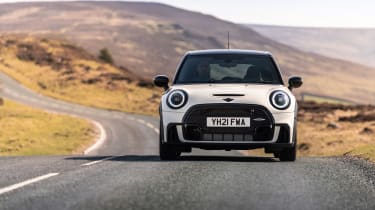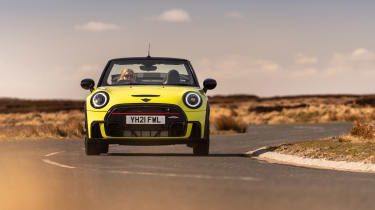Mini Cooper review
Accomplished, but not entertaining, Mini’s core model now feels old and a bit awkward. The next-gen car can’t come quickly enough
The third new era Mini arrived on the scene back in 2013, and in the more than nine years since its introduction it has been pushed, pulled and prodded into every mould you could think of. Yet, at a point when we’d be expecting an all-new derivative, the onset of electrification has meant the current generation will need to live on for a few more years yet, with most of the effort towards the next-generation car being diverted to a new and completely distinctive all-electric interpretation coming later this year.
For now, the ‘F55’ generation is available in its third iteration, with the latest update encompassing mild styling and trim changes. The range of bodystyles also remains, made up of the core three-door hatch, awkward five-door hatch, Convertible and Clubman quasi-estate. Within all of these body types are four engine variants: two three-cylinders and two takes on BMW’s B48 turbocharged four-cylinder petrol. There’s also the Mini Electric, which is only available with the three-door hatchback body, albeit modified to integrate the battery and electric motor’s packaging requirements.
> All-new Mini Cooper SE: design and powertrain specs revealed
As is typically the case with this F-generation Mini, most of its underpinnings are directly borrowed from BMW, sharing key elements of its technical makeup with the front-wheel drive 1 series and X1 crossover. This decision was made to help spread costs and include high-specification technology, but in the process relegated the mechanically sophisticated, but expensive platform of the previous two generations of Mini to retirement.
More reviews
In-depth reviews
Reviews
As a result, no performance derivative of this generation of Mini has yet struck a chord with us in the evo office, including the 302bhp JCW GP3 which promised so much after its two brilliant predecessors. The basic JCW model with a 228bhp variant of the same turbocharged four-cylinder petrol is as tasty as hot Minis get, which is a shame for both us and the wider hot hatchback establishment.
Mini Cooper: in detail
- > Engine, gearbox and technical specs – Combustion engines are now petrol-only; gearboxes are six-speed manual, seven-speed DCT or eight-speed torque-converter automatics
- > Performance and 0-60 time – Its underpinnings might seem generic, but all variants perform well against the stop clock
- > Ride and handling – A quick steering rack, tight suspension calibration and enthusiastic response from the driver controls make it feel peppy, but not exactly engaging
- > MPG and running costs – An over-specification of the available powertrains makes most Minis surprisingly efficient
- > Interior and tech – The retro interior styling remains a love-or-hate attribute, but now the tech is falling behind and those ergonomics haven’t gotten any better over time
- > Design – It's a Mini – which means it looks like a car from the 1950s inflated to 2023 proportions, with limited levels of success. And those tail lights…
Prices, specs and rivals
With the basic Mini One Classic now discontinued, prices start at £22,935 for an ordinary Coupe, opening up the range with a 1.5-litre three-cylinder engine with 134bhp. Standard equipment has been improved over the previous model, with those distinctive LED lights at the front and rear now standard. Mini now also fits a 8.8-inch colour screen across the range, replacing the previous car’s old dot-matrix offering.
Above this you’ll find the Cooper S at £26,490, near-identical in price to the likes of the £26,530 Hyundai i20 N – the i20 is fully specced at that price, though, and is on another level in terms of engagement. The John Cooper Works starts at £32,755 and occupies a sort of no man’s land between traditional superminis and more powerful and more expensive rivals from both mainstream and premium competitors.
Audi’s A1 range has been reduced to occupy the lower end of things, with 94bhp, 108bhp and 148bhp powertrain variants spread between four trim levels costing from £24,145 and rising to £905. If you ask us, we’d rather walk than put up with a 94bhp A1.
Five-door Minis are available in all the same trim levels for a £700 premium, with the Convertible an additional £2955 over the hard-top three-door making it £25,890 at its least expensive. On all trims up to JCW are two optional additional Sport and Exclusive specifications. Sport mimics the JCW’s sportier appearance and equipment list, while Exclusive models pack in leather interior trim, 18-inch alloy wheels and other luxury upgrades – both option packages cost an additional £3000.
The Mini Electric is available in three trim levels distinct from its ICE-powered cousins, and costs from £32,550. Visually there’s little to tell between the two of them aside from some subtle acid yellow detailing. However, look closer and you’ll notice the taller sills and reprofiled wheelarch cladding.
Personalisation has been a key element of the Mini purchasing experience down the years and things are no different now. The Mini is available in a wide range of body and roof colour options, plus there’s extra stripes, coloured mirror caps, varying interior trim and a multitude of wheel designs up to 18 inches. Last year, Mini added a new colour-fade roof option, a process that no doubt looks great in the brochure, but almost certainly has caused a few headaches at the Oxford Mini plant to execute.






